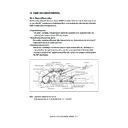Sharp AR-651 (serv.man19) Service Manual ▷ View online
AR-651/810 RADF (DOCUMENT FEEDER) 16 - 65
(5) Drive circuit for large original exit motor, small original exit motor and tray lift motor
Since the large original exit motor, small original exit motor and tray lift motor have almost the same
circuitries, the drive circuits for the small original exit motor and tray lift motor are not described. The
following is the drive circuit for the large original exit motor.
This circuit controls the rotation/stoppage, the direction of the rotation of the large original exit motor and
the motor circuit. The drive pattern signal is input into IC2-5, 6, 16, 17pin to control the speed and
direction of the motor rotation.
The PWM signal is input into LMOT_CU and separated and smoothed at R90, R85 and C86, and it is
input into IC2-3pin(RefA) and14pin(RefB) to set the motor current value. The motor current value can be
changed by altering duties of the PWM signal.
(6) Drive circuit for disengagement solenoid, small original exit solenoid and large original exit solenoid
This circuit controls the closing/opening of the flappers of the disengagement, small original exit and
large original exit solenoids.
When the level of ESSOL, SSOL, LSOL is “H”, Q9, Q10, Q11 are turned ON and the flappers are
closed. The drive signal for the disengagement solenoid is a PWM signal. The flappers are closed in the
maximum torque of the solenoids and the duty value becomes 100% when the flappers start to be
closed. After finishing closing, the duty value is decreased down to 50% and the flappers are kept
closed while the temperature rise of the solenoids is being lowered.
AR-651/810 RADF (DOCUMENT FEEDER) 16 - 66
(7) Reset circuit
This circuit generates a CPU reset signal when the power is turned ON and the power voltage is de-
tected to have become lower.
The level of IC5-6pin (OUT) is normally "H" after the power is turned ON. However, when the power is
turned OFF or the voltage of the +5V power supply is decreased to 4.25V or lower for some reason, the
level of IC5-6pin becomes "L" and the CPU is reset.
(8) EEPROM circuit
This circuit is an EEPROM to store ADF data and its peripheral circuit.
IC3 is a memory to store the adjustment value for reflection-type sensors, and data are sent/received
between IC3 and CPU using a 4-line type serial interface. Data saved in the IC3 is not erased even if the
power is turned OFF.
IC3-1pin (CS) is a chip selection terminal and its level is "H" when data are being sent/received.
IC3-2pin (SK) is a serial clock terminal, and the serial data are sent in synchronization with the clock
input which is input to this terminal.
IC3-3pin (DI) is a input terminal for serial data and IC3-4pin (DO) is an output terminal for serial data.
AR-651/810 RADF (DOCUMENT FEEDER) 16 - 67
This is a circuit to connect to COM with one of the four analog input signals. As following table shows,
the digital signals input into IC7-11pin(A), IC7-10pin(B) and IC7-9pin(C) switch the corresponding chan-
nels and IC7-3pin(COM) at a high speed, and they are input into the A-D input terminal of CPU. Each
channel signal is an analog output signal of the reflective sensor and used to adjust the sensor auto-
matically.
(9) Conversion circuit for D-A
This is a circuit of the D-A converter to converse the digital signal from CPU to the analog signal.
Controls of CPU are done by the serial communications of each DI, CLK, LD signal. The analog output
signals from Ao1 to Ao4 are used to adjust the light intensity of the light emitting diode (LED) of the
reflective sensor. Also, Ao5 and Ao6 output 5V or 0V and are used as the output ports.
(10) Analog multiplexer circuit
C B A
Corresponding Channel
L L L
0
L L H
1
L H L
2
L H H
3
AR-651/810 RADF (DOCUMENT FEEDER) 16 - 68
16. 12. Input/Output Signals
(1) TXD/ACK/REQ signals
This is an input circuit to communicate with the copier. “1” substitutes 5V and “0” substitutes 0V. The
same logic is used in both the connector and CPU input port.
Click on the first or last page to see other AR-651 (serv.man19) service manuals if exist.

